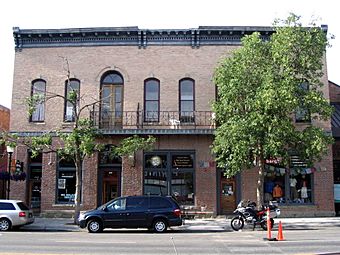Spieth and Krug Brewery facts for kids
Quick facts for kids |
|
|
Spieth and Krug Brewery
|
|

Spieth and Krug Brewery in 2007
|
|
| Location | 238–246 E. Main St., Bozeman, Montana |
|---|---|
| Area | less than one acre |
| Built | 1882 |
| NRHP reference No. | 84002473 |
| Added to NRHP | April 19, 1984 |
The Spieth and Krug Brewery is an old building in Bozeman, Montana. It was once a place where beer was made! Two German immigrants, Jacob Spieth and Charles Krug, started the brewery in 1867. The building you see today was built in 1882. Later, in 1895, a man named Julius Lehrkind bought the brewery. His family still runs drink businesses in Bozeman today. The building is also known as "Union Hall" and "Maxey Block."
Contents
About the Brewery Building
The main building was built between 1882 and 1883. It was made of brick in a Victorian Italianate architecture style. This style was popular for buildings at that time. The first brewery building from 1867 burned down. The new one was built in its place.
How the Building Was Used
The brewery building is built over Bozeman Creek. This creek runs right through downtown Bozeman. The water from the creek was used for making drinks and for keeping things cold.
The top floor of the building was once a dance hall. People would gather there for fun events. Later, in 1945, the second floor was changed. It became known as Union Hall. This was a meeting place for local workers.
In 1983, a restaurant called "John Bozeman's Bistro" opened on the ground floor. It stayed there for many years before moving to a new spot.
History of the Founders
Jacob Friedrich Spieth was born in Germany in 1833. He came to America in 1854. He worked on farms in Ohio and Illinois before moving to Montana in 1863. In Montana, he started mining for gold. He also farmed and raised animals.
Jacob Spieth met Charles Krug in the gold mining camps. Charles Krug was also born in Germany in 1844. He came to America in 1856 and first lived in Missouri. He moved to Virginia City, Montana, in 1864 to mine gold.
Starting the Brewery
Jacob Spieth and Charles Krug started their brewery business in 1867. It grew steadily for about 20 years. Jacob Spieth married Barbara A. Shock in 1871. They had four sons and one daughter.
Charles Krug passed away in 1888. Jacob Spieth then took over Charles's share of the business. Jacob Spieth died four years later in 1892. After their deaths, the brewery was sold.
Lehrkind Takes Over
In 1895, Julius Lehrkind, another German immigrant, moved to Bozeman. He had run a brewery in Iowa for 26 years. Julius bought the Spieth and Krug Brewery. He moved it to a new location in Bozeman and renamed it the Bozeman Brewery.
Julius Lehrkind brought his family and experienced brewers with him. The Bozeman Brewery opened in 1895. It was the biggest building in Bozeman until 1957.
Beyond Brewing
Julius Lehrkind also started making soft drinks soon after opening his brewery. He made drinks like sarsaparilla and lemon soda. In 1914, he got the local Coca-Cola business.
The brewery stopped making beer in 1919 because of Prohibition. This was a time when making and selling alcohol was against the law. However, the Coca-Cola business continued. It is still running today as Lehrkind's Coca-Cola Bottling.
The Lehrkind Mansion, built in 1897, is now a bed and breakfast. It is part of the Bozeman Brewery Historic District.
Images for kids




